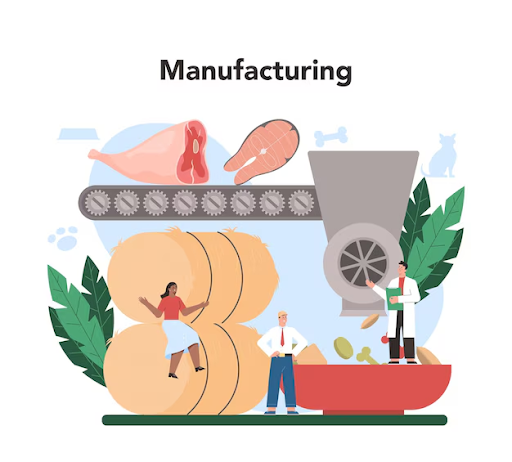This article will analyze the importance of material requirement planning, the benefits it brings, and the common challenges encountered during its implementation.
1. What is material requirements planning?

Material Requirements Planning (MRP) is a planning and management process aimed at accurately determining the quantity and timing needed to supply materials for the production process. The ultimate goal of MRP is to ensure that materials are always available to support the production process, avoiding shortages or excessive inventory.
The main objective of material requirement planning is to ensure that the business always has enough materials to meet production needs while avoiding excessive inventory that leads to waste.
2. Factors affecting the demand for raw materials

The demand for raw materials in production is a dynamic factor, constantly changing and influenced by various factors. Accurately identifying these factors helps businesses plan production effectively, avoiding shortages or excessive inventory.
Below are some key factors that influence the demand for raw materials:
2.1 Internal factors:
Orders:
Order quantity: The number of products ordered by customers will directly determine the demand for raw materials.
Product type: Each type of product will have a different material structure, leading to different material requirements.
Production plan:
Production schedule: A detailed production schedule will clearly determine the timing of material requirements for each stage.
Production capacity: The scale of production will directly affect the amount of raw materials needed.
Inventory:
Current inventory level: The amount of raw materials currently available in stock will affect the decision to place new orders.
Inventory management policy: The policy regarding minimum and maximum inventory levels will determine the reorder point.
Loss, shrinkage:
Shrinkage rate during the production process: A certain amount of raw materials needs to be allocated to compensate for the shrinkage.
Quality of raw materials:
Quality standards: The quality requirements of raw materials will affect the selection of suppliers and the type of raw materials.
2.2 External factors
Market:
Market demand: The fluctuation of market demand will directly impact the demand for raw materials.
Seasonality: For some product categories, the demand for raw materials can vary seasonally.
Competition: The competition from rivals also affects production decisions and the demand for raw materials.
Suppliers:
Supply capability: The supplier's capability in terms of quantity, quality, and delivery time.
Pricing policy: Changes in raw material prices will affect production costs and ordering decisions.
2.3 Objective factors
Natural disasters, epidemics: Unexpected events can disrupt the supply chain and affect the supply of raw materials.
Policy: State policies on taxes, customs, the environment, etc., can also affect prices and the supply of raw materials.
3. The importance of material requirement planning

Material requirement planning is an extremely important activity in the production process of every business. It acts as a "brain" coordinating and ensuring the smooth operation of the entire production line.
3.1 Ensuring continuous production
Accurate material requirement planning is the key to ensuring continuous production and maintaining product quality. When businesses clearly understand the material requirements, they can create detailed production plans, optimize the production process, and ensure a stable supply of materials. This not only helps increase productivity but also contributes to improving product quality, better meeting customer needs, and enhancing competitiveness in the market.
3.2 Cost optimization
Accurate material requirement planning is one of the most important factors in optimizing production costs. By accurately forecasting demand, businesses can place bulk orders, take advantage of supplier discounts, and minimize purchasing costs. At the same time, maintaining an appropriate inventory level helps reduce storage costs, insurance, and other inventory management-related expenses. In addition, minimizing material waste due to overproduction or underproduction also significantly contributes to cost savings.
3.3 Improving production efficiency
Accurately planning material demand not only helps maintain a smooth production flow but also contributes to reducing waste. When a business has a clear material supply plan, they can optimize the production process, reduce waiting times, and minimize material waste. This not only enhances productivity but also helps reduce production costs and increase profits for the business.
For example, in the automobile manufacturing industry: The shortage of a small component can halt the entire production line, causing significant damage in terms of cost and time. In the food industry: If the ingredients are not supplied on time, the products may spoil, causing waste and affecting the company's reputation.
3.4 Improve product quality
Accurate material demand planning is a key factor in ensuring product quality consistency. When the supply of raw materials is stable and continuous, the physical and chemical properties of the product will be maintained evenly, minimizing the occurrence of defective or substandard products. This not only enhances the brand's reputation but also helps the business reduce costs associated with handling defective products.
3.5 Increase flexibility
A good demand planning strategy helps businesses minimize risks from market fluctuations. By accurately forecasting demand and flexibly adjusting the supply of raw materials, businesses can avoid excessive inventory or material shortages, reduce costs, and ensure stable production operations. When there is a clear plan and accurate demand forecasting, businesses can adjust production flexibly, quickly respond to customer needs, while minimizing costs and ensuring stable production operations. This helps businesses maintain their market position and build customer trust.
4. Methods for Material Requirements Planning (MRP)
4.1 MRP (Material Requirements Planning)
MRP is a production planning and management system designed to accurately determine the quantity and timing needed to supply materials for the production process. MRP operates based on calculating the material requirements based on the production plan and inventory data.
The main operational steps of MRP:
- Determine product demand: Based on customer orders, production plans, and market demand forecasts.
- Create a Bill of Materials (BOM): Each product will have a specific Bill of Materials, including components, quantities, and their relationships.
- Calculating material requirements: Based on the BOM and production plan, the MRP system will calculate the amount of materials needed for each production stage.
- Compare with current inventory: Compare the calculated demand with the amount of raw materials currently in stock to determine the additional quantity needed.
- Purchase planning: Create purchase orders for suppliers based on the calculated results.
Advantages of MRP | Limitations of MRP |
|
|
4.2 DRP (Distribution Requirements Planning)
DRP (Distribution Requirements Planning) is a planning system aimed at determining the material and product requirements at distribution points in the supply chain. Unlike MRP, which focuses on production, DRP focuses on managing the flow of products from the factory to the customer.
The main operational steps of DRP:
- Demand forecasting: Based on sales history, market trends, and other factors to forecast demand at sales points.
- Calculating inventory levels: Calculate the optimal inventory levels at each sales point based on demand forecasts, storage costs, and the desired level of customer service.
- Distribution planning: Determine the quantity of goods to be distributed from the central warehouse to the sales points, including the timing and method of transportation.
- Adjusting the plan: Regularly update the plan based on actual sales data, inventory levels, and other influencing factors.
Advantages of DRP | Limitations of DRP |
|
|
4.3 Other forecasting methods
Quantitative forecasting (time series, regression,...).
Qualitative forecasting (Delphi, Jury of executive opinion,...)
5. Challenges in planning material demand

5.1 Data accuracy
The accuracy of data is one of the biggest challenges in material demand planning. Data on orders, inventory, and demand forecasts are often not entirely accurate, leading to discrepancies in material demand calculations. Factors such as sudden market changes, errors in data entry, or the use of incomplete forecasting methods can all reduce the reliability of the data. This leads to a surplus or shortage of raw materials, causing waste and affecting the production process.
5.2 Market fluctuations
Consumer trends are changing rapidly, competition is becoming increasingly fierce, and factors such as policies and unexpected events directly impact customer demand. This makes demand forecasting extremely difficult. The uncertainty about market demand makes it difficult for businesses to accurately determine the necessary amount of raw materials, leading to surpluses or shortages, causing waste and affecting production efficiency.
5.3 The complexity of the supply chain
With globalization, supply chains are becoming increasingly complex, involving multiple suppliers in different countries, numerous intermediaries, and various modes of transportation. This leads to many uncertain and difficult-to-control factors such as:
- Exchange rate fluctuations: Directly affect the cost of importing raw materials.
- Natural disasters and epidemics: These unexpected events can disrupt supply, causing shortages of raw materials.
- National policies: Changes in tax, customs, and quota policies can affect costs and delivery times.
- Delivery delays: Logistics issues, traffic congestion, or incidents during transportation can lead to delayed deliveries, affecting production schedules. Managing a complex supply chain requires businesses to have an effective planning and control system, while also being flexible enough to adapt to market changes.
6. Solutions to improve material demand planning

6.1 Using specialized software
ERP (Enterprise Resource Planning): It is a comprehensive enterprise resource management system, including modules for financial management, human resources, production, sales, and inventory. ERP provides an overview of the entire operations of the enterprise.
MRP (Material Requirements Planning): Is a part of ERP, focusing on planning and managing materials. MRP uses the Bill of Materials (BOM) and production plans to calculate material requirements.
ERP helps consolidate all data related to production, inventory, and sales into a unified system. This helps make data retrieval and analysis faster and more accurate, thereby supporting more effective demand forecasting. Many ERP software systems are integrated with algorithms that automatically calculate material demand based on factors such as orders, forecasts, inventory, and BOM. This helps minimize errors caused by manual calculations.
In addition, ERP helps businesses optimize inventory management, reduce costs, and avoid stockouts. This system closely connects the stages in the supply chain, automates demand calculations, and provides detailed reports, helping businesses make accurate and timely decisions.
6.2 Applying new technologies
IoT (Internet of Things): IoT sensors are attached to machinery, equipment, and raw materials to continuously monitor parameters such as temperature, humidity, inventory levels, and machinery conditions. Thanks to that, businesses can grasp the production situation accurately and promptly.
AI (Artificial Intelligence): AI has the ability to analyze large amounts of historical data, market trends, and customer behavior to provide more accurate demand forecasts, automate many repetitive tasks in the demand planning process, such as data comparison and report generation, allowing employees to focus on higher value-added tasks.
Big Data: Big Data helps businesses collect and analyze a large amount of data from various sources, including internal and external data. Based on the large amount of data, businesses can build more complex forecasting models, which help increase the accuracy of the forecasts.
6.3 Building a close relationship with suppliers
Suppliers often have a lot of information about the market, consumer trends, and factors affecting the demand for raw materials. By sharing information and jointly analyzing data, businesses can make more accurate forecasts. A long-term collaborative relationship helps ensure a stable supply of raw materials, even during periods of market volatility. Suppliers can prioritize delivering goods to loyal customers and can assist in finding alternative sources of supply when necessary.
By building a diverse network of suppliers, businesses can minimize the risk of supply chain disruptions due to unexpected factors such as natural disasters and pandemics.
6.4 Employee Training
Employees need to thoroughly understand the production process, from the product design stage to delivery, in order to comprehend the material requirements at each phase. Training employees to proficiently use planning software such as MRP and ERP to accurately and quickly calculate material requirements. By equipping employees with the necessary knowledge and skills, businesses can significantly improve the material requirement planning process, thereby enhancing production efficiency and increasing competitiveness in the market.
7. Conclusion
Material requirement planning is not only a technical task but also a strategic decision for the business. It directly affects production efficiency, product quality, and market competitiveness. In the future, with the development of technology and increasingly fierce competition, material demand planning will become more important than ever. Businesses need to continuously innovate and apply modern tools and software to optimize this process. To succeed, businesses need to build an intelligent, connected, and automated material requirement planning system. This will help businesses enhance their competitive edge and seize opportunities in the market.